Conway Notation: Difference between revisions
No edit summary |
m (Reverted edits by TrropAscol (Talk); changed back to last version by Drorbn) |
||
| (53 intermediate revisions by 17 users not shown) | |||
| Line 1: | Line 1: | ||
{{Manual TOC Sidebar}} |
{{Manual TOC Sidebar}} |
||
====Conway notation and <tt>KnotTheory`</tt>==== |
|||
Converting Conway notation to other forms known to KnotTheory` (which is a necessary first step in using most of the KnotTheory` functions on knots in Conway notation) requires the package LinKnots` (by M.Ochiai and N.Imafuji, S. Jablan and R. Sazdanovic). See [[Using the package LinKnots`]] for more information. |
|||
<tt>KnotTheory`</tt> understands the Conway notation for knots and links (see {{ref|Conway}} and down below), although the conversion |
|||
between Conway notation and other knot presentations known to <tt>KnotTheory`</tt> (a necessary first step for using most of the KnotTheory` functionality) requires the packages ''K2K'' (KNOT 2000, by M.Ochiai and N.Imafuji) and ''LinKnot'' (by S. Jablan and R. Sazdanovic). For the download and installation of the ''LinKnot'' package see [[Using the LinKnot package]]. |
|||
{{Startup Note}} |
{{Startup Note}} |
||
As in the section [[Using the LinKnot package]], the first step is to add ''LinKnot'' to the Mathematica search path. This path will likely be different on your computer. (Note that you can also |
|||
<!--$$AppendTo[$Path, "/path/to/LinKnots.m"];$$--> |
|||
use Conway notations in <tt>KnotTheory`</tt> if you are using <tt>KnotTheory`</tt> and ''LinKnot'' "in parallel", as described in [[Using the LinKnot package]].) |
|||
<!--$$AppendTo[$Path, "C:/bin/LinKnot/"];$$--> |
|||
<!--Robot Land, no human edits to "END"--> |
<!--Robot Land, no human edits to "END"--> |
||
{{In| |
{{In| |
||
n = 2 | |
n = 2 | |
||
in = <nowiki>AppendTo[$Path, "/ |
in = <nowiki>AppendTo[$Path, "C:/bin/LinKnot/"];</nowiki>}} |
||
<!--END--> |
<!--END--> |
||
<!--$$?ConwayNotation$$--> |
|||
<!--Robot Land, no human edits to "END"--> |
|||
{{HelpAndAbout| |
|||
n = 3 | |
|||
n1 = 4 | |
|||
in = <nowiki>ConwayNotation</nowiki> | |
|||
out= <nowiki>ConwayNotation[s] represents the knot or link whose Conway notation is the string s. ConwayNotation[K], where K is a knot or a link with up to 12 crossings, returns ConwayNotation[s], where s is a string containing the Conway notation of K.</nowiki> | |
|||
about= <nowiki>The program ConwayNotation relies on code from the LinKnot package by Slavik Jablan and Ramila Sazdanovic.</nowiki>}} |
|||
<!--END--> |
|||
A well known example of a knot with an Alexander polynomial equal to the Alexander polynomial of the unknot is the (-3,5,7)-pretzel knot <math>K</math>. Let us verify that, check (using the Jones polynomial) that <math>K</math> is not the unknot and find a (rather unattractive) braid whose closure is <math>K</math>: |
|||
<!--$$DrawMorseLink[K = ConwayNotation["-3,5,7"]] // Show$$--> |
|||
<!--Robot Land, no human edits to "END"--> |
|||
{{Graphics| |
|||
n = 6 | |
|||
in = <nowiki>DrawMorseLink[K = ConwayNotation["-3,5,7"]] // Show</nowiki> | |
|||
img= Conway_Notation_Out_5.gif | |
|||
out= <nowiki>-Graphics-</nowiki>}} |
|||
<!--END--> |
|||
<!--$$Alexander[K][t]$$--> |
|||
<!--Robot Land, no human edits to "END"--> |
|||
{{InOut| |
|||
n = 7 | |
|||
in = <nowiki>Alexander[K][t]</nowiki> | |
|||
out= <nowiki>1</nowiki>}} |
|||
<!--END--> |
|||
<!--$$Jones[K][q]$$--> |
|||
<!--Robot Land, no human edits to "END"--> |
|||
{{InOut| |
|||
n = 8 | |
|||
in = <nowiki>Jones[K][q]</nowiki> | |
|||
out= <nowiki> -12 -11 -10 2 -8 -7 -5 -4 2 -2 1 |
|||
q - q + q - -- + q - q + q - q + -- - q + - |
|||
9 3 q |
|||
q q</nowiki>}} |
|||
<!--END--> |
|||
<!--$$br = BR[K]$$--> |
|||
<!--Robot Land, no human edits to "END"--> |
|||
{{InOut| |
|||
n = 9 | |
|||
in = <nowiki>br = BR[K]</nowiki> | |
|||
out= <nowiki>BR[14, {1, 2, 3, -4, -5, -6, -7, 8, -7, 6, 5, 4, -3, -2, -1, -6, -5, |
|||
-4, -3, -2, 9, 8, 7, 6, -5, 4, -3, 7, -8, -7, -9, -8, 10, 9, -8, |
|||
-11, -10, 12, 11, -10, 9, -8, -13, -12, -11, 10, 9, -8, -7, 6, -5, |
|||
4, -5, -7, 8, -7, -6, -7, -9, 8, -7, 6, 5, -4, 3, 2, -6, -7, -10, |
|||
-9, 11, 10, -9, 8, -7, 6, 5, -4, 3, -6, 5, 4, -6, 5, 7, 6, -7, -8, |
|||
9, 8, -7, 12, -11, 10, -9, 13, -12, 11, -10}]</nowiki>}} |
|||
<!--END--> |
|||
<!--$$BraidPlot[br] // Show$$--> |
|||
<!--Robot Land, no human edits to "END"--> |
|||
{{Graphics| |
|||
n = 11 | |
|||
in = <nowiki>BraidPlot[br] // Show</nowiki> | |
|||
img= Conway_Notation_Out_10.gif | |
|||
out= <nowiki>-Graphics-</nowiki>}} |
|||
<!--END--> |
|||
====Some generalities about the Conway notation==== |
|||
Conway notation was introduced by J.H. Conway in 1967 (see {{ref|Conway}}). The main building blocks for Conway notation are 4-tangles. A 4-''tangle'' in a knot or link projection is a region in the projection plane <math>{\mathbb R}^2</math> (or on the sphere <math>S^3</math>) surrounded with a circle such that the projection intersects with the circle exactly four times. The elementary tangles are: |
|||
<table cellspacing=0 cellpadding=0 border=0 align=center> |
|||
<tr><td>[[Image:tangle0.jpg]]</td><td>[[Image:tangle1.jpg]]</td> |
|||
<td>[[Image:tangle-1.jpg]]</td></tr> |
|||
</table> |
|||
Tangles can be combined and modified by a unary operation <math>a\mapsto-a</math> and three binary operations: ''sum'', ''product'' and ''ramification'', taking tangles <math>a</math>, <math>b</math> to new tangles <math>a+b</math>, <math>a\,b</math> and <math>a,b</math>. Here <math>-a</math> is the image of <math>a</math> under reflection in the NW-SE mirror line, <math>a+b</math> is obtained by placing <math>a</math> and <math>b</math> side by side with <math>a</math> on the left and <math>b</math> on the right. <math>a\,b</math> is simply <math>(-a)+b</math>, and finally, <math>a,b = (-a)+(-b)</math>. |
|||
<table cellspacing=0 cellpadding=0 border=0> |
|||
<tr><td>[[Image:033.jpg]]</td><td>[[Image:ConwayRamification.jpg]]</td></tr> |
|||
<tr><td align=center>Sum and product of tangles</td><td align=center>Ramification of tangles</td></tr> |
|||
</table> |
|||
A ''rational tangle'' is any tangle obtained from the elementary tangles using only the operation of product. A ''rational knot'' or a ''rational link'' is the numerator closure of a rational tangle. A knot or link is called ''algebraic'' if it can be obtained as the closure of a tangle obtained from rational tangles using the operations above. |
|||
Knot or links that can not be obtained in this way are called ''non-algebraic''. They can all be obtained in the following manner: start with a ''basic polyhedron'' <math>P</math>, a 4-valent graph without digons, with vertices numbered <math>1</math> through <math>n</math>. Now substitute tangles <math>t_1</math> through <math>t_n</math> into these vertices. |
|||
The Conway notation for such knots and links consists of the symbol <math>ni^\star</math> of a basic polyhedron <math>P</math> where <math>n</math> is the number of vertices and <math>i</math> is the index of <math>P</math> in some fixed list of basic polyhedra with <math>n</math> vertices, followed by the symbols for the tangles <math>t_1</math> through <math>t_n</math> separated by dots. |
|||
For example, the knot [[4_1]] is denoted by "2 2", the knot [[9_5]] by "5 1 3", the link [[L5a1]] is denoted by "2 1 2", the link [[L9a24]] by "3 1,3,2" (all of them contain spaces between tangles), etc. A sequence of k pluses at the end of Conway symbol is denoted by +k, and the sequence of k minuses by +-k (e.g., knot [[10_76]] given in Conway notation as 3,3,2++ is denoted by "3,3,2+2", and the mirror of the link [[L9n21]] whose Conway notation is 3,2,2,2-- is given by "3,2,2,2+-2"). The space is used in the same way in all other symbols. |
|||
For the basic polyhedra with <math>N<10</math> crossings the standard notation is used (.1 , 6*, 8*, 9*, where the symbol for 6* can be ommitted). For example, the knot [[10_95]] is denoted by ".2 1 0.2.2", and [[10_101]] by "2 1..2..2". For higher values of <math>N</math> a notation is used in which the first number is the number of crossings, and the next is the ordering number of polyhedron (e.g., 101*, 102*, 103* for <math>N=10</math> denoting 10*, 10**, 10***, respectively, and 111*, 112*, 113* for <math>N=11</math> denoting 11*, 11**, 11***, respectively, ''etc''.). |
|||
The order of basic polyhedra for <math>N=12</math> corresponds to the list in {{ref|Caudron}}, so 121* to 1212* denote the basic polyhedra originally titled as 12A-12L. For <math>N>12</math> the database of basic polyhedra is produced from the list of simple 4-regular 4-edge-connected but not 3-connected plane graphs generated by Brendan McKay using the program "plantri" written by Gunnar Brinkmann and Brendan McKay (http://cs.anu.edu.au/~bdm/plantri/). PolyBase.m is automatically downloaded and it contains basic polyhedra up to 16 crossings. In order to work with the basic polyhedra up to 20 vertices, one needs to open an additional database PolyBaseN.m, for <math>N=17</math> to <math>N=20</math> (by writing, e.g. <<PolyBase17.m or Needs["PolyBase17.m"] for <math>N=17</math>). |
|||
Note: Together with the classical notation, Conway symbols are given in the book ''Knots and Links'' by D.~Rolfsen. However if you try to draw some knots or links from their Conway symbols the obtained projection might be non-isomorphic with the one given in Rolfsen, for example knot [[9_15]] denoted in Conway notation as 2 3 2 2 gives projection with 5, and not 4 digons. |
|||
{{note|Caudron}} A. Caudron, ''Classification des noeuds et des enlancements''. Public. Math. d'Orsay 82. Orsay: Univ. Paris Sud, Dept. Math., 1982. |
|||
{{note|Conway}} J. H. Conway, ''An Enumeration of Knots and Links, and Some of Their Algebraic Properties.'' In Computation Problems in Abstract Algebra (Ed. J. Leech). Oxford, England: Pergamon Press, pp. 329-358, 1967. |
|||
Latest revision as of 17:22, 27 May 2009
Conway notation and KnotTheory`
KnotTheory` understands the Conway notation for knots and links (see [Conway] and down below), although the conversion between Conway notation and other knot presentations known to KnotTheory` (a necessary first step for using most of the KnotTheory` functionality) requires the packages K2K (KNOT 2000, by M.Ochiai and N.Imafuji) and LinKnot (by S. Jablan and R. Sazdanovic). For the download and installation of the LinKnot package see Using the LinKnot package.
(For In[1] see Setup)
As in the section Using the LinKnot package, the first step is to add LinKnot to the Mathematica search path. This path will likely be different on your computer. (Note that you can also use Conway notations in KnotTheory` if you are using KnotTheory` and LinKnot "in parallel", as described in Using the LinKnot package.)
In[2]:=
|
AppendTo[$Path, "C:/bin/LinKnot/"];
|
|
| ||||||||
A well known example of a knot with an Alexander polynomial equal to the Alexander polynomial of the unknot is the (-3,5,7)-pretzel knot . Let us verify that, check (using the Jones polynomial) that is not the unknot and find a (rather unattractive) braid whose closure is :
In[6]:=
|
DrawMorseLink[K = ConwayNotation["-3,5,7"]] // Show
|
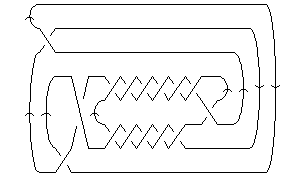
| |
Out[6]=
|
-Graphics-
|
In[7]:=
|
Alexander[K][t]
|
Out[7]=
|
1
|
In[8]:=
|
Jones[K][q]
|
Out[8]=
|
-12 -11 -10 2 -8 -7 -5 -4 2 -2 1
q - q + q - -- + q - q + q - q + -- - q + -
9 3 q
q q
|
In[9]:=
|
br = BR[K]
|
Out[9]=
|
BR[14, {1, 2, 3, -4, -5, -6, -7, 8, -7, 6, 5, 4, -3, -2, -1, -6, -5,
-4, -3, -2, 9, 8, 7, 6, -5, 4, -3, 7, -8, -7, -9, -8, 10, 9, -8,
-11, -10, 12, 11, -10, 9, -8, -13, -12, -11, 10, 9, -8, -7, 6, -5,
4, -5, -7, 8, -7, -6, -7, -9, 8, -7, 6, 5, -4, 3, 2, -6, -7, -10,
-9, 11, 10, -9, 8, -7, 6, 5, -4, 3, -6, 5, 4, -6, 5, 7, 6, -7, -8,
9, 8, -7, 12, -11, 10, -9, 13, -12, 11, -10}]
|
In[11]:=
|
BraidPlot[br] // Show
|
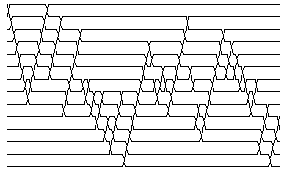
| |
Out[11]=
|
-Graphics-
|
Some generalities about the Conway notation
Conway notation was introduced by J.H. Conway in 1967 (see [Conway]). The main building blocks for Conway notation are 4-tangles. A 4-tangle in a knot or link projection is a region in the projection plane (or on the sphere ) surrounded with a circle such that the projection intersects with the circle exactly four times. The elementary tangles are:
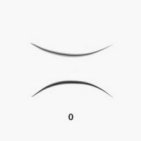 |  |
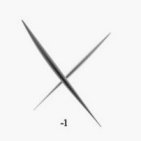 |
Tangles can be combined and modified by a unary operation and three binary operations: sum, product and ramification, taking tangles , to new tangles , and . Here is the image of under reflection in the NW-SE mirror line, is obtained by placing and side by side with on the left and on the right. is simply , and finally, .
 | 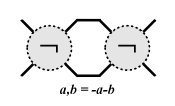 |
| Sum and product of tangles | Ramification of tangles |
A rational tangle is any tangle obtained from the elementary tangles using only the operation of product. A rational knot or a rational link is the numerator closure of a rational tangle. A knot or link is called algebraic if it can be obtained as the closure of a tangle obtained from rational tangles using the operations above.
Knot or links that can not be obtained in this way are called non-algebraic. They can all be obtained in the following manner: start with a basic polyhedron , a 4-valent graph without digons, with vertices numbered through . Now substitute tangles through into these vertices.
The Conway notation for such knots and links consists of the symbol of a basic polyhedron where is the number of vertices and is the index of in some fixed list of basic polyhedra with vertices, followed by the symbols for the tangles through separated by dots.
For example, the knot 4_1 is denoted by "2 2", the knot 9_5 by "5 1 3", the link L5a1 is denoted by "2 1 2", the link L9a24 by "3 1,3,2" (all of them contain spaces between tangles), etc. A sequence of k pluses at the end of Conway symbol is denoted by +k, and the sequence of k minuses by +-k (e.g., knot 10_76 given in Conway notation as 3,3,2++ is denoted by "3,3,2+2", and the mirror of the link L9n21 whose Conway notation is 3,2,2,2-- is given by "3,2,2,2+-2"). The space is used in the same way in all other symbols.
For the basic polyhedra with crossings the standard notation is used (.1 , 6*, 8*, 9*, where the symbol for 6* can be ommitted). For example, the knot 10_95 is denoted by ".2 1 0.2.2", and 10_101 by "2 1..2..2". For higher values of a notation is used in which the first number is the number of crossings, and the next is the ordering number of polyhedron (e.g., 101*, 102*, 103* for denoting 10*, 10**, 10***, respectively, and 111*, 112*, 113* for denoting 11*, 11**, 11***, respectively, etc.).
The order of basic polyhedra for corresponds to the list in [Caudron], so 121* to 1212* denote the basic polyhedra originally titled as 12A-12L. For the database of basic polyhedra is produced from the list of simple 4-regular 4-edge-connected but not 3-connected plane graphs generated by Brendan McKay using the program "plantri" written by Gunnar Brinkmann and Brendan McKay (http://cs.anu.edu.au/~bdm/plantri/). PolyBase.m is automatically downloaded and it contains basic polyhedra up to 16 crossings. In order to work with the basic polyhedra up to 20 vertices, one needs to open an additional database PolyBaseN.m, for to (by writing, e.g. <<PolyBase17.m or Needs["PolyBase17.m"] for ).
Note: Together with the classical notation, Conway symbols are given in the book Knots and Links by D.~Rolfsen. However if you try to draw some knots or links from their Conway symbols the obtained projection might be non-isomorphic with the one given in Rolfsen, for example knot 9_15 denoted in Conway notation as 2 3 2 2 gives projection with 5, and not 4 digons.
[Caudron] ^ A. Caudron, Classification des noeuds et des enlancements. Public. Math. d'Orsay 82. Orsay: Univ. Paris Sud, Dept. Math., 1982.
[Conway] ^ J. H. Conway, An Enumeration of Knots and Links, and Some of Their Algebraic Properties. In Computation Problems in Abstract Algebra (Ed. J. Leech). Oxford, England: Pergamon Press, pp. 329-358, 1967.


























